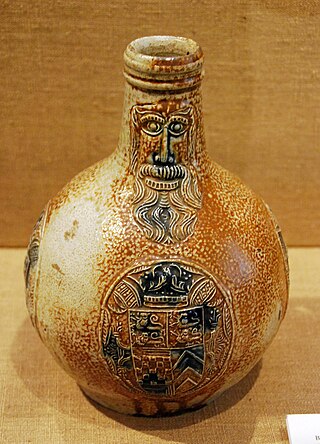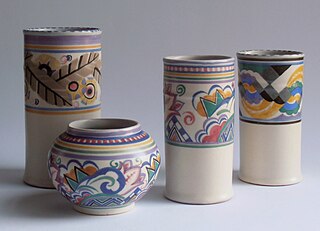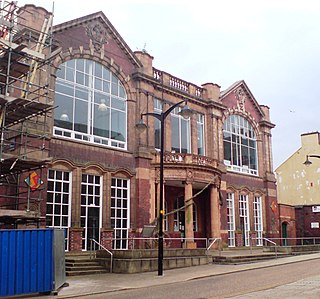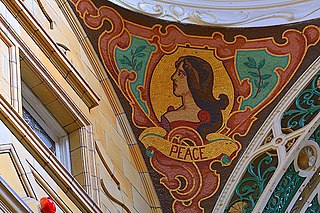
Delftware or Delft pottery, also known as Delft Blue or as delf, is a general term now used for Dutch tin-glazed earthenware, a form of faience. Most of it is blue and white pottery, and the city of Delft in the Netherlands was the major centre of production, but the term covers wares with other colours, and made elsewhere. It is also used for similar pottery, English delftware.

Salt-glaze or salt glaze pottery is pottery, usually stoneware, with a glaze of glossy, translucent and slightly orange-peel-like texture which was formed by throwing common salt into the kiln during the higher temperature part of the firing process. Sodium from the salt reacts with silica in the clay body to form a glassy coating of sodium silicate. The glaze may be colourless or may be coloured various shades of brown, blue, or purple.

Poole Pottery is a British pottery brand, now based in Stoke on Trent, Staffordshire, England. As a company, it was founded in 1873 on Poole quayside in Dorset, where it continued to produce pottery by hand before moving its factory operations away from the quay in 1999. Production continued at a new site in Sopers Lane until its closure in 2006. The name is now a brand for products made in Staffordshire. Historical products from Poole Pottery are displayed in the Victoria and Albert Museum in London.

Medieval Islamic pottery occupied a geographical position between Chinese ceramics, the unchallenged leaders of Eurasian production, and the pottery of the Byzantine Empire and Europe. For most of the period it can fairly be said to have been between the two in terms of aesthetic achievement and influence as well, borrowing from China and exporting to and influencing Byzantium and Europe. The use of drinking and eating vessels in gold and silver, the ideal in ancient Rome and Persia as well as medieval Christian societies, is prohibited by the Hadiths, with the result that pottery and glass were used for tableware by Muslim elites, as pottery also was in China but was much rarer in Europe and Byzantium. In the same way, Islamic restrictions greatly discouraged figurative wall-painting, encouraging the architectural use of schemes of decorative and often geometrically-patterned titles, which are the most distinctive and original specialty of Islamic ceramics.

Clifton is a suburb of Swinton in the City of Salford in Greater Manchester, England. It lies along the edge of Irwell Valley in the north of the City of Salford. Historically in Lancashire, it was a centre for coal mining, and once formed part of the Municipal Borough of Swinton and Pendlebury.

Burslem School of Art was an art school in the centre of the town of Burslem in the Potteries district of England. Students from the school played an important role in the local pottery industry. Pottery was made on the site of the school from the early Middle Ages. The venue was refurbished and re-opened for the arts in 1999.

Mintons was a major company in Staffordshire pottery, "Europe's leading ceramic factory during the Victorian era", an independent business from 1793 to 1968. It was a leader in ceramic design, working in a number of different ceramic bodies, decorative techniques, and "a glorious pot-pourri of styles - Rococo shapes with Oriental motifs, Classical shapes with Medieval designs and Art Nouveau borders were among the many wonderful concoctions". As well as pottery vessels and sculptures, the firm was a leading manufacturer of tiles and other architectural ceramics, producing work for both the Houses of Parliament and United States Capitol.

Burmantofts Pottery was the common trading name of a manufacturer of ceramic pipes and construction materials, named after the Burmantofts district of Leeds, England.

Ceramic glaze is an impervious layer or coating of a vitreous substance which has been fused to a pottery body through firing. Glaze can serve to color, decorate or waterproof an item. Glazing renders earthenware vessels suitable for holding liquids, sealing the inherent porosity of unglazed biscuit earthenware. It also gives a tougher surface. Glaze is also used on stoneware and porcelain. In addition to their functionality, glazes can form a variety of surface finishes, including degrees of glossy or matte finish and color. Glazes may also enhance the underlying design or texture either unmodified or inscribed, carved or painted.

Alan Caiger-Smith MBE was a British ceramicist, studio potter and writer on pottery.

Shiwan ware is Chinese pottery from kilns located in the Shiwanzhen Subdistrict of the provincial city of Foshan, near Guangzhou, Guangdong. It forms part of a larger group of wares from the coastal region known collectively as "Canton stonewares". The hilly, wooded, area provided slopes for dragon kilns to run up, and fuel for them, and was near major ports.

Royal Tichelaar Makkum is a Dutch pottery company in Makkum. After initially producing bricks and later pottery and tiles, the company has focused on traditional decorative pottery since 1890. As the company in Makkum has always made ceramics, Royal Tichelaar Makkum is regarded as one of the oldest companies in the Netherlands. The Royal Tichelaar Makkum has always specialized in stoneware and earthernware, and started making porcelain from 1999. The first Dutch porcelain dates to 1759, with the advent of Weesp porcelain.
Pilkington's Group Plc was a UK-based manufacturer and supplier of wall and floor coverings and building materials. The group had a history in ceramic tile manufacturing with the head office located on Rake Lane in Clifton Junction, near Manchester, England. The Pilkington's Manufacturing Ltd brand is currently owned by a Polish group of companies Rovese S.A - the second largest tile manufacturer in Europe.
Pilkington is a multinational glass manufacturing company headquartered in St Helens, United Kingdom.

Art pottery is a term for pottery with aspirations, made in relatively small quantities, mostly between about 1870 and 1930. Typically, sets of the usual tableware items are excluded from the term; instead the objects produced are mostly decorative vessels such as vases, jugs, bowls and the like which are sold singly. The term originated in the later 19th century, and is usually used only for pottery produced from that period onwards. It tends to be used for ceramics produced in factory conditions, but in relatively small quantities, using skilled workers, with at the least close supervision by a designer or some sort of artistic director. Studio pottery is a step up, supposed to be produced in even smaller quantities, with the hands-on participation of an artist-potter, who often performs all or most of the production stages. But the use of both terms can be elastic. Ceramic art is often a much wider term, covering all pottery that comes within the scope of art history, but "ceramic artist" is often used for hands-on artist potters in studio pottery.
Gordon Mitchell Forsyth (1879–1952) was a Scottish ceramic designer and fine artist and art education innovator.

Franciscan Ceramics are ceramic tableware and tile products produced by Gladding, McBean & Co. in Los Angeles, California, from 1934 to 1962, International Pipe and Ceramics (Interpace) from 1962 to 1979, and Wedgwood from 1979 to 1983. Wedgwood closed the Los Angeles plant, and moved the production of dinnerware to England in 1983. Waterford Glass Group plc purchased Wedgwood in 1986, becoming Waterford Wedgwood. KPS Capital Partners acquired all of the holdings of Waterford Wedgwood in 2009. The Franciscan brand became part of a group of companies known as WWRD, an acronym for "Wedgwood Waterford Royal Doulton." WWRD continues to produce the Franciscan patterns Desert Rose and Apple.
The Rye Pottery is a pottery in Rye, East Sussex, England, known as the Cadborough Pottery or "Rye Pottery" from its beginnings in c. 1834 to 1876, and Belle Vue Pottery from 1869 until it closed in 1939. It was revived as the "Rye pottery" in 1947 by the brothers Walter and John Cole, who became known for their tinglazed wares. During the 19th and early 20th centuries it produced earthenware in a distinctive style of sprigged applied relief decoration, sometimes supplemented by inscriptions using printer's type, which was marketed as "Sussex Rustic Ware". Often the texture of surfaces imitated tree bark. From c. 1840 to 1930 it was owned by members of the Mitchell family.

Ceramic art is art made from ceramic materials, including clay. It may take forms including artistic pottery, including tableware, tiles, figurines and other sculpture. As one of the plastic arts, ceramic art is one of the visual arts. While some ceramics are considered fine art, such as pottery or sculpture, most are considered to be decorative, industrial or applied art objects. Ceramics may also be considered artefacts in archaeology. Ceramic art can be made by one person or by a group of people. In a pottery or ceramic factory, a group of people design, manufacture and decorate the art ware. Products from a pottery are sometimes referred to as "art pottery". In a one-person pottery studio, ceramists or potters produce studio pottery.

Millicent (Millie) Jane Taplin (1902–1980) was a British designer and painter of ceramics who spent most of her career at Josiah Wedgwood and Sons (1917–1962). She was trained in painting by Alfred and Louise Powell, and supervised Wedgwood's ceramics painters. She became a designer of decorative patterns in 1929 and by the mid-to-late 1930s was one of the company's main designers, although she did not design pottery shapes. She was one of only two working-class women to become a successful ceramics designer before the Second World War. Her tableware designs were exhibited by Wedgwood at Grafton Galleries in London in 1936, and several of her designs are now on display at the V&A Museum. Her design "Strawberry Hill", with Victor Skellern, was awarded the Council of Industrial Design's Design of the Year Award in 1957.


















